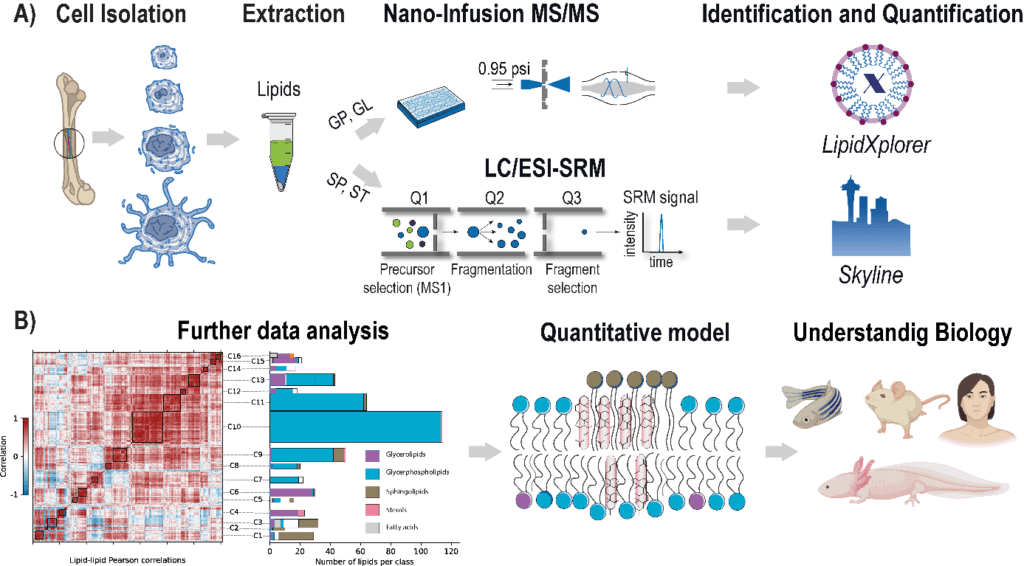Oslo, Norway – [July 2nd 2024] – A collaborative team of leading scientists has published a crucial guide addressing the common pitfalls in lipid mass spectrometry analyses of mammalian samples. The paper, titled “Pitfalls in Lipid Mass Spectrometry of Mammalian Samples – A Brief Guide for Biologists,” aims to improve the accuracy of lipid data reported in scientific studies.

Figure 1: Quantitative lipidomics workflow. A) sample isolation, extraction, and analysis of lipids using internal lipid standards. Lipid data analysis and biological interpretation of analyzed cell membranes. This figure was partially generated with Biorender.
Despite being common and vital biomolecules in living organisms, lipids pose a significant challenge due to their broad biological diversity, which encompasses thousands of chemical structures with high similarities. The current lipid mass spectrometry methodologies often fail to correctly determine the lipids, leading to misreporting and incorrect biological interpretations. It is in this context that the guide, titled ‘Pitfalls in Lipid Mass Spectrometry of Mammalian Samples-A Brief Guide for Biologists,’ has been published. Its aim is to improve the accuracy of lipid data reported in scientific studies by addressing these challenges.
Addressing a recurring issue in mass spectrometry (MS) analyses of lipids, the guide specifically focuses on the inclusion of lipid species that are likely nonexistent in mammalian samples. By offering simple guidelines, it aims to assist any scientist in submitting accurate lipid data and to aid reviewers and editors in evaluating these submissions effectively. This, in turn, can significantly reduce the incidence of erroneous lipid species reported, thereby enhancing the quality of scientific studies and paving the way for more accurate and reliable lipid data in the future.

Figure 2: Authors of the article Pitfalls in Lipid Mass Spectrometry. From left to right Prof. Dr. Kirsten Sandvig, Dr. Kim Ekroos, Prof. Dr. Jeffrey McDonald, Prof. Dr. Robert Ahrends, Dr. Gerhard Liebisch, Dr. Tore Skotland
Mass spectrometry is a powerful technique widely used to determine the lipid composition of biological samples. Despite comprehensive articles that describe the correct procedures for conducting these analyses, many studies still need to be revised. The guide, authored by Skotland, Ekroos, McDonald, Ahrends, Liebisch, and Sandvig, specifically targets biologists working with mammalian samples and focuses on the major lipid classes: phospholipids, glycerolipids, and sphingolipids.
The team emphasizes the importance of adhering to established protocols and exercise critical judgment when interpreting MS data to avoid misreporting lipid species. By following the guidelines proposed in this commentary, researchers can enhance the reliability and reproducibility of their lipidomics studies.
About the Authors:
- Tore Skotland, Oslo University Hospital
- Kim Ekroos, Lipidomics Consulting Ltd
- Jeffrey McDonald, University of Texas
- Robert Ahrends, University of Vienna
- Gerhard Liebisch, University Hospital of Regensburg
- Kirsten Sandvig, Oslo University Hospital and the University of Oslo
The authors represent a distinguished collaboration of experts from renowned institutions, including Oslo University Hospital and the University of Oslo, Lipidomics Consulting Ltd, the University of Texas, the University of Vienna, and the University Hospital of Regensburg. Their collective expertise spans the fields of lipidomics, biochemistry, cell biology, and mass spectrometry, ensuring a comprehensive and authoritative guide for the scientific community.
References:
This guide is a vital resource for biologists engaged in lipid mass spectrometry. It offers practical advice to enhance the accuracy of lipid data and support the integrity of scientific research.
